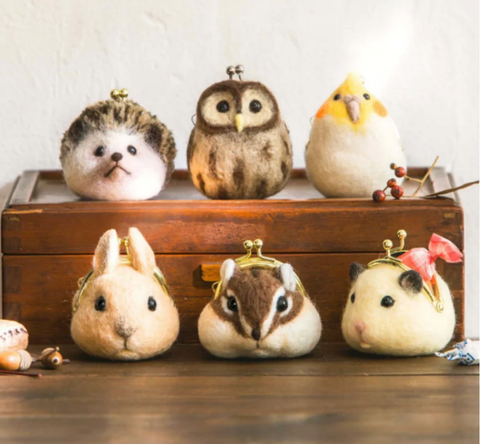Needle felting is a craft technique that involves sculpting wool fibers into shapes using a special barbed needle. Here are the basic steps to needle felting:

-
Gather your materials: You will need wool roving or batting, a needle felting needle, a foam pad or felting mat, and any additional materials you want to add to your project.
-
Create a base: If you are making a three-dimensional object, start by creating a base shape out of wool roving or batting. You can use your hands to shape the wool, or you can use a needle to shape it more precisely.
-
Add layers: Once you have a base shape, begin adding layers of wool to build up the shape and create more definition. Use a needle to attach the layers together and to sculpt the wool into the desired shape.
-
Work slowly: Needle felting requires patience and precision. Work slowly and carefully, using small, deliberate movements to shape the wool.
-
Add details: Once you have the basic shape of your project, you can add additional details like eyes, ears, or other features. Use smaller amounts of wool and more delicate movements to create these details.
-
Finish your project: When you are satisfied with your project, carefully trim any loose fibers and secure any loose ends with a needle. You can also add additional embellishments like beads or embroidery to finish your project.
-
Clean up: Needle felting can be messy, so be sure to clean up any loose fibers or scraps when you are finished. Store your materials in a safe, dry place until you are ready to needle felt again.

Electric needle felting machine-needle felting tools
Remember, needle felting can be a fun and rewarding hobby, but it does require some practice and patience to get the hang of it. Start with simple projects and work your way up to more complex designs as you become more comfortable with the technique.
here are some additional tips for successful needle felting:
-
Choose high-quality materials: The quality of your wool roving or batting can make a big difference in the success of your project. Look for wool that is soft, dense, and easy to work with.
-
Use the right needle: There are different types of needle felting needles available, each with different numbers and sizes of barbs. Use a medium or coarse needle for shaping and a fine needle for detail work.
-
Be careful with the needle: Felting needles are sharp and can cause injury if not used properly. Use a foam pad or felting mat to protect your work surface and keep your fingers away from the needle.
-
Experiment with color: Wool roving comes in a variety of colors, so don't be afraid to experiment with different combinations and shades to create unique projects.
-
Practice patience: Needle felting can be a slow process, so don't rush or force the wool into shape. Take your time and work in small sections to achieve the desired result.
-
Don't be afraid to start over: If you're not happy with how a project is turning out, don't be afraid to start over or make adjustments. Needle felting is a forgiving craft, and you can always add more wool or reshape existing layers.
needle felting animals kit for beginners with tutorials
With these tips in mind, you should be well on your way to creating beautiful and unique needle felted projects. Remember to have fun and enjoy the process!
Here are some more tips for successful needle felting:
-
Use a variety of needle sizes: Depending on the size and detail of your project, you may want to use a variety of needle sizes to achieve the desired result. Experiment with different needles to see which work best for your project.
-
Create a template: If you are making a specific shape or design, it can be helpful to create a template or sketch to guide your work. This can help ensure that your finished project looks the way you want it to.
-
Use wire or armature for support: If you are making a three-dimensional project that requires support, consider using wire or armature to provide structure. This can help your project maintain its shape over time.
-
Incorporate other materials: While wool roving is the primary material used in needle felting, you can also incorporate other materials like fabric, yarn, or beads to add texture and interest to your projects.
-
Take breaks: Needle felting can be a repetitive and precise craft, so it's important to take breaks to rest your hands and eyes. Stretch your fingers and take breaks every so often to avoid strain or discomfort.
-
Practice good technique: To get the best results with needle felting, practice good technique. Use a light touch with the needle, and avoid pulling or twisting the wool too aggressively.
By following these tips, you can create beautiful and unique needle felted projects with confidence and ease. Don't be afraid to experiment and try new things - the possibilities with needle felting are endless!


